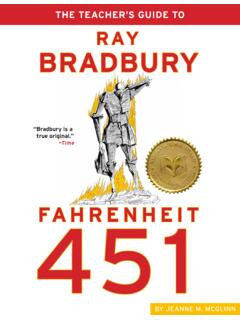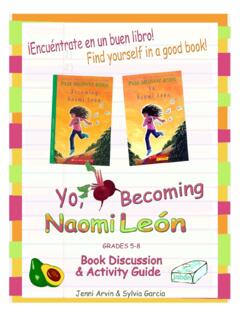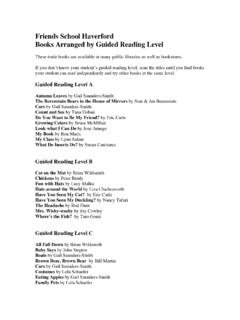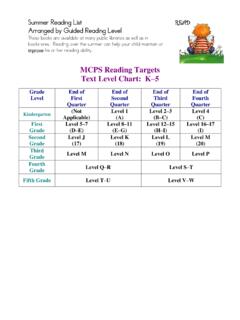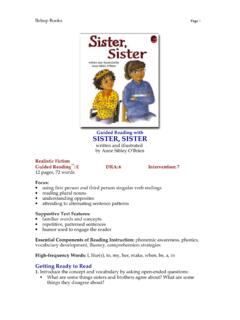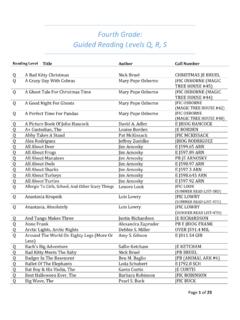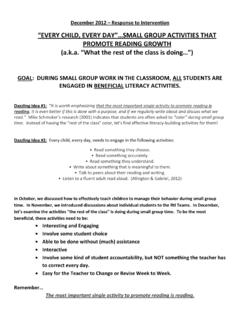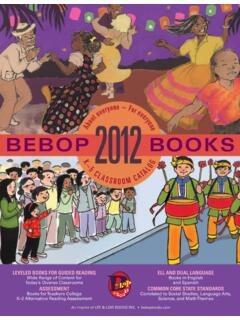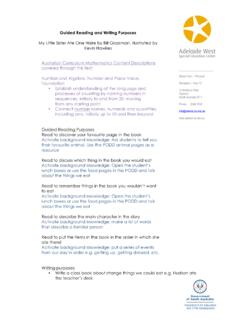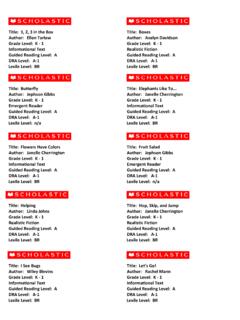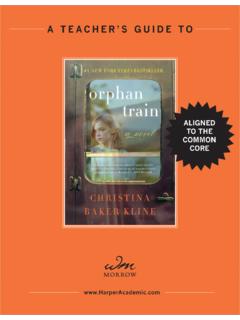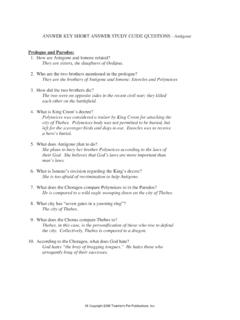Transcription of Guided Reading with ELIZABETI’S DOLL - TeachingBooks.net
1 Bebop Books Page 1 Guided Reading with elizabeti S DOLL written by Stephanie Stuve-Bodeen illustrated by Christy Hale Realistic Fiction Guided Reading : I DRA: 16 Intervention: 16 32 pages, 578 words Guided Reading Note: Level I is the benchmark for the end of first grade. Children Reading at this level are in an early fluent stage, and the focus emphasizes comprehension and independent Reading . Most of the Reading should be done silently. Children are encouraged to: 1) make connections between their own experiences and the story, 2) get the author s message and be able to discuss it with other readers, and 3) apply their Reading skills and strategies. Most importantly, children should feel confident and eager to read. This is a time to build fluency and independence as children read a variety of genres and develop a sense of Reading for different purposes.
2 Focus: understanding the author s message connecting personal experiences with a story thinking about similarities and differences drawing conclusions and making inferences following a longer story with varied sentence structures Supportive Text Features: familiar words and concepts Bebop Books Page 2 narrative sentence and text form sequential events Essential Components of Reading Instruction: Phonics: initial /wh/ consonant digraph; word ending -ed spelling pattern/sound exploration Vocabulary: poked, splashed, behaved, burp, polite, wrapped, relieved, chores, kanga, village, lullaby; contractions; possessives: adding apostrophe s Fluency: reread the story independently or with a partner Comprehension: determine what is important, make connections, ask questions High-frequency Words: had, a, of, him, and, she, to, for, her, have, so, went, up, it, but, on, the, then, was, just, when, had, he, very, little, too, that, did, back, with , saw, get, from, out, be, into, put, this, how, where, all, were, look(ed), in, one, at, they, away, day, make Getting Ready to Read 1.
3 Introduce the concept and vocabulary by asking open-ended questions: ! Have you ever used your imagination to pretend you have something you d like to have, but don t have? What did you pretend to have? ! What kinds of things do you play with when you pretend? Are they real or pretend things? ! You all know what a doll is. If a child didn t have a doll, what other things could be played with like a doll? 2. Connect children s past experiences with the book vocabulary: ! Call children s attention to the title. Read: elizabeti s Doll. ! Ask children to use the title and picture on the cover to predict what they would expect to read about in the story. ! Show the back cover and read the copy. Ask children to think about how elizabeti might care for her doll. ! Have children suggest some words they might expect to find in the story.
4 ! Give children the book and have them look through it. Ask them to find some hints about what happens in the story. 3. Remind children of the strategies they know and can use with unfamiliar words: ! Ask them, What will you do if you come to a word you don t know? ! Encourage children to look for chunks of words they know and to blend the sounds quickly. ! Suggest that children read on past an unfamiliar word in order to use the context of the story to unlock the word. ! Tell children also to think about what they know about taking care of babies. Then encourage them to choose a word that makes sense in the sentence. 4. Be aware of the following book and text features: Bebop Books Page 3 ! The book contains numerous high-frequency words and many other familiar words. ! Text placement and the amount of text on each page varies.
5 ! The story is told in the narrative form. Throughout the beginning, there is a parallel structure between Mama s actions and elizabeti s actions. ! The events are sequential and real, although the African setting may be unfamiliar to children. ! The story has a clearly defined Setting/Problem/Solution/Outcome format. ! Contractions and possessives are used throughout the story. ! The illustrations support and extend the text, but most of the meaning is contained in the text. Reading the Book 1. Set a purpose by telling children to read about a girl who finds a special doll to care for, just like her mother cares for the new baby in the family. 2. Have children read the story silently. Each child should be Reading at his or her own pace. After the group has read a few pages, check for understanding with simple comments such as: What is the story about?
6 Or Tell me how the story begins. Then direct them to continue Reading . As they read, watch for indications of comprehension: changes in facial expressions, giggles, audible comments, rereading, turning back to a page. You may want to make notations about these noticings. 3. Look for these Reading behaviors during children s first Reading : ! Do they rely on the print while Reading ? ! Do they have a strong sight vocabulary? ! Do they use known sound chunks to read unknown words? ! Are they showing signs of understanding the story? ! Are they monitoring meaning and rereading when they lose meaning? ! Do they easily move from page to page? ! Are they using punctuation to gain meaning? ! How are they using the pattern at the beginning of the book? ! Do they make accurate predictions? ! Are they connecting the text to their own experiences?
7 ! Do they react to the text even though they are Reading silently? 4. As children read, note what they are doing. Help them build independence by being available, but not intervening too quickly. ! Watch for changes in children s facial expressions and use these as signals to ask questions such as: What made you smile? or Where do you need some help? ! Encourage children s attempts by making comments such as: I like how you are using a different strategy when the first one you try doesn t work. ! If children are struggling with deciding which strategy to use, suggest a specific strategy that would help them get meaning in the most efficient way, such as, Did you think about chunking that word? Bebop Books Page 4 5. Possible teaching points to address based on your observations: ! Review how to find a known part or sound chunk in an unknown word.
8 ! Show children how to use analogies to move from the known to the unknown when encountering new words. ! Review using grammar (syntax) to unlock words by considering the sentence structure or parts of speech in the sentence. ! Model asking questions or making I wonder .. statements to extend comprehension. ! Review how to determine what is important in a story. Discuss the way the story is structured using the Setting/Problem/Solution/Outcome format. ! Talk about similarities and differences between the setting of the story and the communities where children live. ! Call attention to the following contractions: didn t, wouldn t, couldn t, wasn t. Review the use of an apostrophe to take the place of the missing letters. ! Talk about adding an apostrophe plus s to nouns to form the possessive: elizabeti s, Obedi s, Eva s, family s.
9 Review how this shows belonging to or possession. ! Work with the ending -ed and explore the different sounds the spelling pattern can represent: /d/sound in filled, /t/ sound in wrapped. Also explore how the -ed ending gives information about when an action occurred. ! Work with words from the story with initial /wh/consonant digraph: when, which, while. Explore other words with these sounds. ! Model how to revisit the text to find specific examples or ideas in the story. Revisit elizabeti S DOLL to find places in the story where children made personal connections. After the First Reading 1. Have children confirm their predictions about what happened in the story. 2. Connect the story with children s experiences. Discuss how parts of the story are similar to their lives or experiences and how other parts are different.
10 3. Ask children to talk about things that surprised them in the story, or new information they learned. 4. Elicit children s thoughts about elizabeti s doll. Talk about being creative and making their own playthings. 5. Have children explore elizabeti s changing emotions and feelings. Go through the story, having volunteers read one or two pages aloud at a time. Then talk about how elizabeti felt and why. Second Reading 1. Have children reread the book silently or to a partner. Bebop Books Page 5 2. This is a time for assessment. Keeping notes on children s progress during Guided Reading session will be a helpful resource for giving children on-going feedback about themselves as readers as well as helping you record how they develop over time. ! While they are Reading , watch what children do and what they use from the teaching time.




